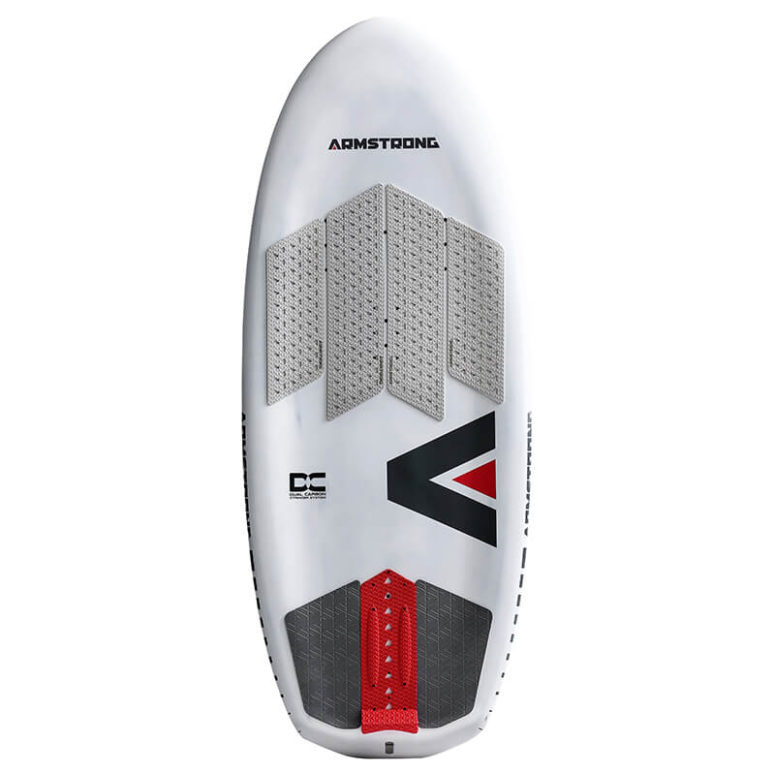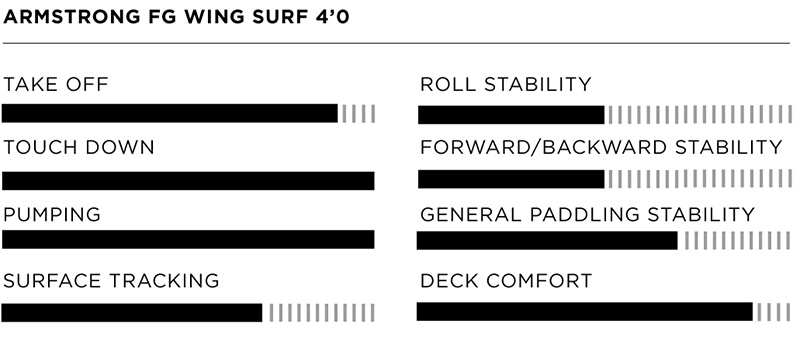

When you purchase gear through links on our site, we may earn a small commission. Here’s why you can trust our tests and our affiliate partner.

Upon releasing the FG series, Armstrong introduced not only a new shape, but an evolution in production foilboard geometry that’s an indicator of things to come across the industry. Combined with a high finish quality, ease of use, and playful ride, this one’s a real winner.
If you’d like a detailed walkthrough on the thinking behind the FG series, I recommend referring to our interview with Armie in the previous issue (Summer 2021). Out of the box, the board is packaged in Armstrong’s standard board bag. While not padded to handle global travel, the plush handles, solid zipper set, and generous Velcro-lined foil slit make this bag a great daily solution. The board itself is finished beautifully in a sanded gloss white, with hardly an imperfection visible to my keen eye. It’s a simple, thermally efficient finish. Thin red and gray pads come factory installed, with a bridged stomp pad at the tail. Its subtle scooped deck is deceptively simple, but well thought out. The same goes for the board’s bottom contours. Nothing revolutionary until arriving at the foil boxes, which are 320mm/12.5in in length, nearly 50mm/2in longer than average! When combined with their generally forward-biased position in the board, these boxes definitely live up to the “Forward Geometry” name.
In fairness, while I didn’t weigh this board on a scale, it feels very slightly heavier than other ultralight production boards it’ll be compared to. This is due to a truly beefy construction consisting of dual carbon stringers, 120g Innegra, a PVC sandwich deck, and double carbon wrapped rails. Should that seem like overkill, remember this board is designed as a dual-purpose wing and surfing board. If it has any chance of surviving serious jumps and airs, it better be bomber.
To the water, then. At 27L in volume, this 4’0 paddles comfortably for its size. For some context, I’m 155lbs/70kg and typically ride boards in the 18-22L range — so take my definition of comfortable with a grain of salt. Dropping in, the scooped deck holds the chest well without being restricting. On foil, Armstrong’s deck pads have just the right level of grip where shuffling one’s stance is easily accomplished. The first few carves are a revelation. Much like the uniquely smooth, secure and precise feel of Armstrong’s foils, this board is really confidence inspiring in the surf. Rail grabs and whitewater hits feel balanced and controlled throughout the maneuver. Pumping is similarly positive, and the board feels direct and alive. Duckdiving is an easy affair thanks to those thin front rails that offer a good angle in hand. As for placing a foil in the long tracks, this is an area to continue exploring. With my Lift Surf 150v2 attached, foil placement was around the 4.5 tick mark, which is hardly even halfway. With so much forward real estate left over, I’m sure there will be loads to explore on this board for every rider. The potential of such geometry for different riding styles on a variety of foil types is perhaps its most exciting feature — it’s a board that everyone can grow into.
If you can paddle a 27L board, I definitely recommend trying the 4’0. It’s a real bucket of fun. While Forward Geometry might sound daunting, I see it as an exciting new way to incrementally develop the way we ride hydrofoils. And if a forward-mounted foil isn’t your thing quite yet, then just slide it on back and you’ve still got a terrific board for the money.
